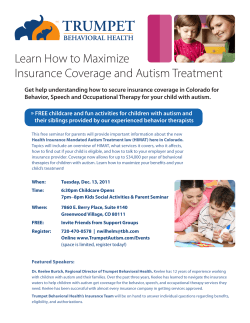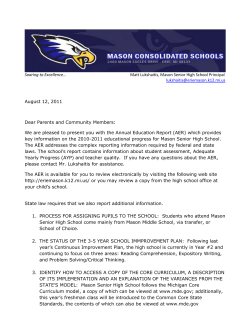
Document 389295
Dominant research focus on deficits Inclusive research methodology with children rarely used Challenges: › The ‘nature ‘ of autism › Access and consent › Suitable research methods 2 Reluctance to participate Concrete thought processes Difficulty in talking about the future Lack of personal insight Dislike of change (Preece, 2002) 3 Autism Spectrum Disorders (ASD) • Autism • Asperger’s Syndrome • Pervasive Developmental Disorder • Higher Functioning Autism • Atypical Autism Repetitive or Unusual Behaviour Two-way Social Interaction Communication & use of Language Dislike Change Prefer Routine (Klin, Lang, Cicchetti, & Volkmar, 2000; Bailey, Palferman, Heavey, & Le Couteur, 1998; Chakrabarti & Fombonne, 2005; Le Couteur et al., 1996; Lord, Leventhal, & Cook Jr., 2001) 4 Ethical and methodological dilemmas Access and consent • Tension between the rights of children to participate in research, and the carers’ responsibility to protect them. • Adult preconceptions about children's participation abilities Research methodology Traditional research approaches unsuitable Traditional data collection methods lack flexibility A single method is not likely to suit all (Beresford, Tozer, Rabiee, & Sloper, 2004; Kelly, 2005; Kelly, McColgan, & Scally, 2000; Morris, 2003; Preece, 2002) 5 Focus on Teenagers › knowledge, strengths and preferences Collaborative participatory Teenagers authoritative › Qualitative methods › Issues within broad topic areas Analysis aimed to identify meanings › Collective › Individual ‘New’ Sociology of Childhood Social Models of Disability (Including Alderson & Morrow, 2004; Christensen & James, 2000; Christensen & Prout, 2002; Davis, 1998; Davis, Watson, & Cunningham-Burley, 2000; Kelly, 2005; Kelly, McColgan, & Scally, 2000; Mason & Urquhart, 2001; Oliver, 1990; Thomas, 1999; Prout & James, 1990) 7 ‘New’ Sociology of Childhood Children as social actors Co-constructors of knowledge Taking children’s views seriously Lives in the present and thoughts on the future (Alderson, 2001; Fattore & Mason, 2005; Fattore, Mason, & Nixon, 2005; Mayall, 2002; Prout & James, 1990) 8 Impairment physical, cognitive, communication or sensory limitations Disability oppressive barriers, negative attitudes, lack of support, access or equipment Social (relational) Model of Disability Questions ‘social norms’ (Davis, 2000; Morris, 2003; Oliver, 1990, Thomas, 1999) 9 Research phases Means of Methods Communication Purpose 1 Parent consultation Phone Semistructured interviews •Parent recruitment & consent •Preliminary info about teenager communication requirements 2 Parent & Teenager consultation Face to face Semistructured interviews •Teenager recruitment & consent •I.D. methods & communication strategies 3 Individual engagement of teenagers (2 – 5 visits + other contact) •Face to face •SemiData collection process structured interviews •‘Being-with’ (Verbal, Signs, Cards) (Verbal, written, signs, photos, pictures) •Email (written) 10 Six participants 13 – 18 years of age 2 females 4 males Secondary education › Main stream classes with varying support › School for specific purposes (SPSS) 11 Social Stories ™ (Gray, 2002; Gray & Garand, 1993) Modified Social story (Beresford, Tozer, Rabiee & Sloper, 2004) 12 Lise would like to see what John* is doing at school today - Is this ok? John can say or nod his head John can say or shake his head Can Lise take some photos of John? John can hold STOP card have a break to stop or (*Not participants real name. Use of photo permitted) 13 Semi-structured interviews › Face to face › Email Being-with › Participant observation › Active participation › Interaction 14 Strategies › › › › › › › › Communication Toolbox Preparing participants Individualising questions Rephrasing questions Clarifying answers Parent assistance Using humour Using Individuals’ own ideas 15 16 Strategies › Max 4 questions per email › Setting the scene › Prompt response to participant email Benefits › › › › Convenient Cost effective Efficient Generates written data › › › › No body language observations Access to computer and internet Computer literacy May compromise young people’s privacy & confidentiality Limitations 17 Strategies › Preparation › Spending time in several settings › Observing and interacting › Taking photos and making video clips › Interactive Activities (Use of photos permitted) 18 Talking mat™ (Cameron & Murphy, 2002) Write draw and talk Profile map 19 Participation abilities and competencies of young people with autism differ. › Important to value diverse forms of knowledge and contribution 20 Difficulty convincing adults that young people’s views are important › Researchers must be prepared to continually emphasise value of young people’s views. 21 Sensitivity › Abilities › Preferences Reciprocity › › › › Style of Communication Develop rapport Avoiding ambiguity Individualizing interviewing style Flexibility Respect 22 Young people diagnosed with autism Were a diverse group Had something to communicate Had different views to their parents Had different knowledge of and interest in autism › Did not think autism was always most important in their lives › › › › 23 Alderson, P. (2001). Research by children. International Journal of Social Research Methodology, 4(2), 139-153. Alderson, P., & Goodey, C. (1996). Research with disabled children: How useful is child-centred ethics? Children & Society, 10, 106-116. Alderson, P., & Morrow, V. (2004). Ethics, social research and consulting with children and young people. Essex: Barnado's. Beresford, B., Tozer, R., Rabiee, P., & Sloper, P. (2004). Developing an approach to involving children with autistic spectrum disorders in a social care project. British Journal of Learning Disabilities, 32(4), 180-185. Christensen, P., & Prout, A. (2002). Working with ethical symmetry in social research with children. Childhood, 9(4), 477-497. Davis. (1998). Understanding the meanings of children: A reflexive process. Children & Society, 12, 325-335. 24 Davis. (2000). Disability studies as ethnographic research and text: Research strategies and roles for promoting social change. Disability & Society, 15(2), 191-206. Davis, Watson, N., & Cunningham-Burley, S. (2000). Learning the lives of disabled children. In P. C. A. James (Ed.), Research with children: Perspectives and practices. London: Falmer Press. Fattore, T., & Mason, J. (2005). Working seriously towards new partnerships. In J. Mason & J. Fattore (Eds.), Children taken seriously in theory, policy and practice. London: Jessica Kingsley. Fattore, T., Mason, J., & Nixon, D. (2005). Participation: Count me in! Involving children and young people in research. Sydney: NSW Commission for children and young people, and Social Justice and Social Change Research Centre, University of Western Sydneyo. Document Number) Fattore, T., Mason, J., & Watson, E. (2007). Children's conceptualisation(s) of their wellbeing. Social Indicators Research, 80, 5-29. Kelly, B. (2005). 'Chocolate...makes you autism': Impairment, disability and childhood identities. Disability & Society, 20(3), 261275. 25 Kelly, B. (2007). Methodological issues for qualitative research with learning disablde children. International journal of Social Research Methodology, 10(1), 21-35. Mason, J., & Urquhart, R. (2001). Developing a model for participation by children in research on decision making. Children Australia, 26(4), 16-21. Mayall, B. (2002). Towards a sociology for childhood: Thinking from children's lives. Buckingham: Open University Press. Morris, J. (2003). Including all children: Finding out about the experiences of children with communication and/or cognitive impairments. Children & Society, 17(5), 337-348. Preece, D. (2002). Consultation with children with autistic spectrum disorders about their experience of short-term residential care. British Journal of Learning Disabilities, 30, 97-104. Prout, A., & James, A. (1990). A new paradigm for the sociology of childhood? Provenance, promise and problems. In A. J. A.Prout (Ed.), Constructing and reconstructing childhood: Contemporary issues in the sociological study of childhood. London: Falmer Press. 26
© Copyright 2025










